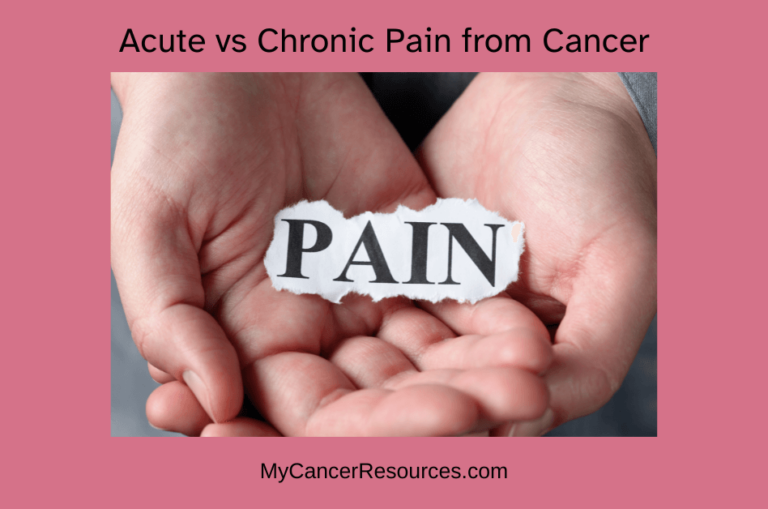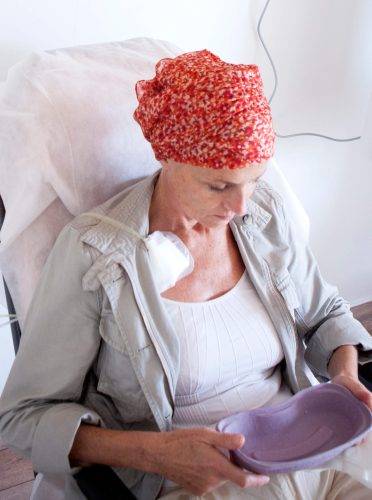
Unfortunately, pain can be a big part of the cancer experience for some people. Pain can be caused by several issues that we’ll explore here. There are different types of pain, which is classified as acute vs chronic pain.
The main difference between these kinds of pain is how long it lasts.
Acute pain comes on suddenly and can need immediate medical attention.
Chronic pain is more constant pain, where pain signals continue to fire in the central nervous system over a long period of time.
Both types can be severe pain – one isn’t stronger than the other.
Both are serious and can require complementary and medical treatments to provide relief.
Treatment options can differ depending on if a person is suffering from acute vs chronic pain.
This article explores effective pain management, including pain medicine and complementary therapies.
The Underlying Causes of Cancer Pain
Acute cancer pain can be a result of a tumor pressing on nerves, sending out sharp pain signals.
Acute pain can be sudden and is the body’s way of saying, “Hey! Pay attention – something is really wrong here!”
Surgery is a common treatment option for many cancers, and the recovery from a surgical procedure can be painful as incisions heal and nerves regrow.
If tumors have spread to the bones and weakened them, bones can easily break.
A broken bone causes immediate, sharp pain, but can also have some dull, chronic aches as the bone heals.
Chronic cancer pain can also come from a constant pressure of tumors that cannot be surgically removed.
Some chemotherapy drugs can lead to joint pain. This chronic pain can be hard to relieve, as each joint in the body can feel inflamed and painful to move.
Neuropathy, or neuropathic pain, can also be a side effect of cancer treatments.
While this involves shooting or burning acute pain, the condition is ongoing, so it can also be considered chronic pain.
If a limb is amputated, like in the case of osteosarcoma (bone cancer), phantom pain from where the limb used to be is another type of cancer-related chronic pain.
Some, like my mother-in-law, experience both acute and chronic pain because of their cancer.
Her tumor pressed on her spinal cord and created ongoing, intense pain.
The tumor also compressed the surrounding nerves sending sharp, shooting pains down her legs.
All this constant low back pain made it hard for her to walk, and sitting and even lying down was uncomfortable.
As a caregiver, I know how hard it can be wanting to take away someone’s pain when treatment options aren’t working.
I felt helpless when her pain caused limited mobility, a lack of energy, and little relief from her constant discomfort.
My emotional upset was nowhere near the level of pain she was experiencing though.
I’m so thankful that once hospice got involved, they worked hard to find the right combination of medicines to keep her comfortable and reduce her suffering.
Strategies and Treatment Options for Managing Cancer Pain
Treating pain requires a multidisciplinary approach.
This means a group of professionals from different specialties work together to address and manage pain.
Medical doctors work with pain specialists to address the specific cause of the pain.
Physical therapists create exercise plans to relieve pain.
Social workers and psychologists can help by teaching ways to cope with the emotional effects of chronic pain.
Treatments will vary depending on the source of the pain and whether you’re experiencing acute or chronic pain symptoms.
The purpose is to provide immediate and ongoing relief and improve the quality of life that’s been affected as the result of pain.
Pain relieving medicines range from over-the-counter medicines to stronger prescriptions.
From acetaminophen to NSAIDs like ibuprofen to stronger prescription medications like opioid-based pills and patches, there are many medicines that can be used for pain relief.
Gabapentin is another drug I’ve seen used successfully for many people with cancer, especially for nerve pain.
It’s technically an anticonvulsant drug, but it relaxes muscles and changes the way the body senses nerve pain.
Nerve blocks kill or numb a nerve to stop it from causing pain.
Typically, doctors will try to control your pain with minor pain relievers first before moving to stronger medicines.
Since the United States has had such a problem with the over-prescription and abuse of opioids, doctors are much more aware of potential problems with opioids.
I’m seeing more and more cancer treatment teams recommend complementary therapies along with medication to provide better relief.
Of course, this isn’t the case when someone enters hospice.
Since hospice patients typically have less than 6 months to live, the focus is less on whether the patient will develop a tolerance for opioids and more on around the clock pain relief.
I’m thankful for this approach, because in her last 6 weeks, my mother-in-law relied on regular and pretty high doses of both gabapentin and morphine to stay comfortable.
Non-Medical and Complementary Pain Relief Options
There are many non-medicine options that can be tried to see if they help control pain.
Physical therapy increases mobility and loosens tense muscles.
Electrical stimulation places small pads on the skin that release small electrical charges.
This blocks the nerves that carry pain messages to the brain.
Acupuncture uses tiny needles inserted into the skin at certain pressure points.
This stimulates nerves and muscles and can increase the body’s ability to manage pain, and restore blood flow to help heal damaged nerves.
Massage therapy relaxes the body and has been shown to reduce the intensity and severity of pain in people with cancer.
Another study showed that reflexology and hand acupressure can significantly decrease cancer pain.
An over-the-counter product we used on both my mother-in-law and my aunt as her ovarian cancer progressed and she had breakthrough pain was this hemp pain relief cream (affiliate link).
It absorbs quickly with a gentle massage and works right away. I still use it today for the aches and pains of my entire family.
Aromatherapy, the use of essential oils, has also been shown to reduce pain when combined with conventional treatments.
Essential oils like peppermint, wintergreen, and lavender can be inhaled or mixed with a carrier oil like coconut oil and applied to the skin for pain relief.
Taking an Active Role in Managing Pain
Whether you are experiencing acute vs chronic pain as a result of cancer, it’s important to actively work with your caregiver and healthcare team to effectively manage your pain.
Learning about the different treatment options that are available for pain control is an important first step.
Track your pain levels and patterns to see if there is a common trigger for pain or if it is worse at certain times of the day.
This can help your team decide which treatments and medicines to use throughout the day to minimize your discomfort.
Open and honest communication with your caregivers and healthcare providers is important so you remain comfortable.
Don’t feel like you have to keep a ‘stiff upper lip’ or not talk about your pain so you don’t feel like a burden to anyone.
It’s important that you share how you’re truly feeling so that you can have effective pain relief and maintain a good quality of life.
If the emotional trauma of dealing with cancer is adding to your pain, I’m here to help.
We can talk through what you’re experiencing, and as your ability to cope with your diagnosis improves along with feeling mentally and emotionally supported, you may find your pain levels to be less overwhelming too.
Reach out to me today and we can work together to ensure you’re thriving through this cancer journey, rather than struggling to survive.



